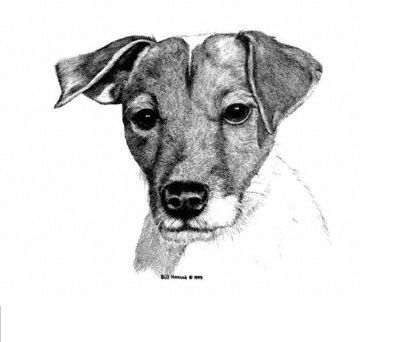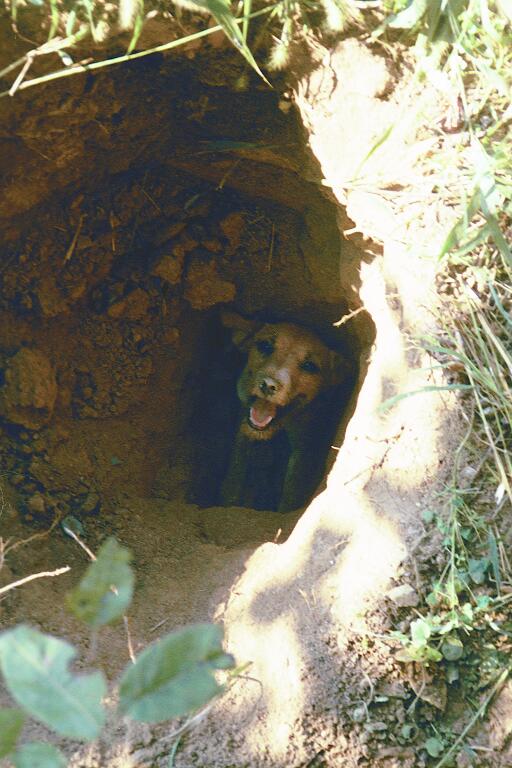| |
|
Searching
for the Questing Beast
| ...In
which the goal is find "the right
dog"... |

And
have you seen said beast, my lady?" asked
Lancelot.
"Well not precisely," stammered Elayne.
"But if father says it is there well, it
must be. Simply must."
4The
Once and Future King,
by T.H.
White, in which Lancelot asks the daughter of
King Pelinore if she has actually seen the
beast her father has spent a lifetime
searching for.
How do you
find the "right" dog from a "good
breeder"?
Heck if I know, but I
think it's a good question. For what it's worth,
here's my most recent experience looking for
"the perfect dog" -- in this case the
perfect hunting terrier.
Having owned terriers, in one form or another, for
more than 30 years, I decided the time was ripe to
get a hole dog for hunting purposes -- a small dog
capable of going to ground on groundhogs, raccoon and
fox.
The breed I had in mind was a Jack Russell Terrier.
I started by writing
down what I wanted from a dog. Above all else,
I was looking for a "hole dog" for
hunting. I grouped my preferences into three
categories:
1)
MUST
HAVE (very small female out of solid
hunt stock);
2) SHOULD HAVE (smooth or very
lightly broken coat), and;
3) WOULD LIKE
to have (a dog
with color and strong markings).
The first question I
had to face: How small should a good "hole
dog" be?
This was harder to get
a handle on than I thought. Most of the people
I knew who hunted their dogs used
mini-doxies as "hole dogs." Most of the border
and jack russell terriers I had seen in the field
were too big to get past the first turn or two in a
groundhog den. I would need a SMALL dog --
smaller than normally found in the show ring, for
sure.
I found the best
definitive source on terrier size to be Ken James'
book on working terriers in North America. He
boils it down to this: get a dog with a chest
span of under 14" chest.
This proved harder
than it sounded.
I began my search by
combing through the Jack Russell Terrier Club of
America's (JRTCA) breeder directory and assembling a list of e-mail
contacts from the surrounding seven states. Then I wrote a
very nice pitch letter knowing I would get ONE chance to sell myself
to a good breeder. I contacted every breeder I could that
looked like they raised small terriers, detailing my yard set up
(pretty close to perfect), the fact that I had raised dogs for a
long time, that I was not a breeder, that I was looking for a hole
dog for hunting groundhog, that I had never lost a dog to a
car accident, etc.
I also stressed what I was looking for: a small
hole dog with a chest of under 14 inches, a smooth or
lightly broken coat, and female (my border is male
and I wanted to avoid conflict, but most of all I
wanted a small dog which meant female).
The results were interesting. All the
breeders were very nice and most mailed back a
response very quickly. None had a dog that fit
my description. A few breeders said they
thought I was in for a long wait as getting a small,
smooth, well-balanced female was like hitting the
Trifecta or the lottery.
A couple of folks told me they had dogs that
were "going to be small" but when I started
asking about dam and sire size (both shoulder height
and chest span) they were either vague or quoted
numbers too large.
Lesson one:
"Small" is in the eye of the
beholder.
A 13" dog is bigger than what I wanted, but is
considered "perfect" by show
standards. A lot of people -- even the very
best breeders -- had no idea how large their dogs
were around the chest.
A lot of people were breeding 13 inch tall dogs to 13
inch tall bitches and saying they expected the pup to
be "under 12 inches." Perhaps, but
not likely and I needed better odds than not
likely.
I steeled myself against all temptation, persuasion
and fatigue. This was going to be a long
push. I didn't need a cute dog, I needed a hole
dog.
One of the top JRT breeders (and a judge!) said she
had a litter of pups on the ground I should come out
and take a look at -- they were going to be very
small. When I drove out to look at
the litter, I found 4 enormous puppies with
putty-colored noses and pastel eyes. I bit my
tongue, thanked her for the coffee, and moved on. No
harm, no foul, buyer beware. Caveat emptor.
I attended JRTCA shows. All the dogs were too
big.
I finally spied one dog that might have been
possible. As luck would have it, the mating
that produced her was being repeated (the dam was
already pregnant). I talked up the owner (a
vet) and waited 8 weeks. When the pups
were born, I drove 270 miles out to see the pups, but
took a pass on the two bitches that were in the
litter -- too big. This was a hard decision to
make at 3 weeks of age and after 3 hours of
driving in a car, but I felt I was right then
and I KNOW it was right now.
I cast about looking for another litter from the same
stud dog -- a 12-inch tall prepotent
JRTCA bronze medallion hunt champion that stamps
his pups like the Millers Forge tool
company.
I drove to see another set of his pups -- only one
female -- and took a pass here too -- the head seemed
too weak. I called Ken James and talked to
him. Did he have a female pup by any chance, or
know of someone who might? Nope. His very
last bitch pup was promised to a very nice lady whom
I happened to know. This dog was going to a
GREAT home, and I was out of luck.
By now, four months had gone by. I e-mailed all
the breeders again, letting them know I was still
looking for a small smooth bitch. Once again, I
was told there was very little chance I would find
the dog I wanted.
After five months of DAILY activity, I had yet to
find a pup that could make the grade.
Frustrated, I began combing through the JRTCA breeder
registry looking for small smooth-coated bitches that
did well in conformation. I talked to a breeder
in a western state who said she had a good dog and she
emailed me a picture of a very nice looking
pup. The breeding line was good -- a
breeding to a hunt dog famous for having a small
chest. I asked for the pedigree and I got
all five generations.
I combed through it and decided there were
simply too many big dogs just one and two generations
back.
I had ONE chance to get a "hole dog", and I was not
going to blow it. I passed. Ditto for
another dog in California. I contacted more
breeders, and got more lectures that the dog I wanted
was VERY rare. I was told almost no one bred
dogs as small as I was looking for, since they were
"all caesarian" and the most the breeder
could hope for was 2 pups after all those medical
expenses -- a real financial bath for the
breeder. Yep. I got that. But these
dogs DO exist. I waited.
Then I got a call from a lady in Virginia who said she said she might
know of a pup for me. The dam was one of her
bitches which was now owned by a vet living
along the Virginia-Tennessee border. She was a small
broken bitch out of a line that consistently threw
small pups. The stud dog was the very same
12" prepotent hunt champ whose pups I had
been looking at earlier. There had been four
pups in the litter (not a caesarian), and she had been down to see
them. The pups were almost four months old now,
and SMALL. She guaranteed they were going to be
hole dog-sized.
I
emailed the vet with the pups, and she sent back a picture which really DID look like a
female puppy version of the
stud dog. Her email also said the pup was
catching moles on a daily basis at just 14 weeks of
age. It could be a come-on story, but what
the hell. What's a 7 hour car trip?
At the end of the week I loaded myself into the car
and drove down to the Tennessee border.
The short story is that I picked up the pup and it
was exactly what I wanted. The pup was hunting
moles when I arrived. This little Jack is now
14 months old, stands just under 11 inches at the
shoulder, and has a 12.75 inch chest. She looks
very much like her sire which is a very good
thing in my eyes. A sweet dog that will
curl in your lap like a cat, she began formal earth
hunting the day she turned 10 months old. I am,
in short, a very happy camper!
What did I learn from all this?
1) You need to know what it
is you want out of a dog;
2) You need to stick to your
guns on what it is you want;
3) You need to learn to read
a pedigree;
4) You need to realize that
many breeders are very optimistic -- they
really "hope" you get what you want in
a dog, but it's YOUR JOB to make sure that
happens and to not "be nice" by taking
an animal that is less than what you want;
5) Some people will overtly
lie to you while others will simply
"fail to mention" things if you don't
ask -- caveat emptor always applies,
and;
6) People will respect you
for knowing what it is you want and waiting
for it.
In the end, I think it
was the sixth point that got me my dog. Over
the seven months that I very actively searched for
my dog (I was a canine stalker) I proved myself
"worthy" among those that actually had very
small dogs in their own breeding lines.
Because I was not willing to compromise, I got points
with this community. Because I was persistent
they remembered me when the right dog finally did
show up.
On Saturday, we're going hunting in
Maryland.

Sailor, a happy
dog, in the field.
Now somewhat grizzled, and a veteran of more
than 300 digs, she continues to work everything
she can find in a hole.
|
|
|
